Once again we are off to lands far away as we continue on The Bread & Soup Project. This time, we’re off to central west Africa and the Republic of Cameroon. For our usual comparison, it’s just a shade larger than California, by about 8%, but only has 2/3 the population.  As a former split British and French colony, the two main official languages are English and French, with a smattering of indigenous languages, Arabic, and two forms of pidgin – “Cameroonian Creole” which consists of half a dozen English pidgin dialects, primarily based in the part of the country that used to be British, and “Camfranglais” which is a blend of the Cameroonian dialects of English and French, with a bit of the Creole thrown in as well, and primarily in the former French territories. About 40% of the country’s population are Catholic, 25% Protestant, 25% Muslim, and the balance mostly a mix of tribal specific religions.
As a former split British and French colony, the two main official languages are English and French, with a smattering of indigenous languages, Arabic, and two forms of pidgin – “Cameroonian Creole” which consists of half a dozen English pidgin dialects, primarily based in the part of the country that used to be British, and “Camfranglais” which is a blend of the Cameroonian dialects of English and French, with a bit of the Creole thrown in as well, and primarily in the former French territories. About 40% of the country’s population are Catholic, 25% Protestant, 25% Muslim, and the balance mostly a mix of tribal specific religions.
Cuisine-wise, most dining is centered on a large evening meal, focused on different starches, including taro, yams, plantains, maize, yuca, rice, and more. It’s common that whichever starch or combination of them is used, they’re pounded into a paste with water, and either cooked or not, formed into a sort of thick pudding-like mass that’s often used to dip into sauces made from greens, peanuts, spices, and small amounts of meat (beef and goat seem to be most common) and fish or crayfish, though these, as well as the occasional chicken, are too expensive for a large percentage of the population. Daytime eating tends towards bread, fruit, and banana or bean based pastries, as well as leftovers from the previous evening meal.
Now, as has happened more than once in this project, I hit a wall when it came to ingredients – not just in terms of availability, but even in having a clue what many of them were. Particularly in regard to the “soups”, many of which tended to be more sauce-like, accompanied by the aforementioned starch masses, there were simply things that even with research I’d have had little to no idea what they should taste like. Luckily, I stumbled across a Cameroon-centric blog and youtube feed, published by a lovely Cameroonian woman, Precious Meshi Nkeih, whose suggestions, detailed recipes and videos were invaluable. My versions here had a few substitutions for local ingredients and a bit of variance from hers, mostly with suggestions from some other online recipes, but they’re, in general, pretty close to hers.
Starting to socialize a bit more, I invited a couple members of The Horde to join for dinner, and went the extra mile, preparing not only Egusi Soup, and a popular bread (mostly for breakfast) called Kumba Bread, but also the Cameroonian version of an empanada, the Cameroonian Meat Pie. And, away we go!
Let’s start with the bread. 500gm bread flour, 100gm powdered milk, 2 tablespoons of sugar, 1 teaspoon of salt, 1/2 teaspoon nutmeg, 2 teaspoons instant yeast, and about 250ml of warm water. That makes for a fairly low hydration dough, only about 40%, and that’s somewhat stiff to work with. I got a request from a local customer to make one for them too the next day, and I tried it with a bit more water and liked the results more – about 50% hydration, or 300ml.
After kneading, let it rise until doubled in volume.
Punch down, and then put into a well oiled loaf pan. Also oil the top of the dough.
Let rise again, and bake – about 20 minutes in a hot oven.
Yum. Really yum. And a great breakfast bread with the nutmeg and sugar in it. The nutmeg also works really well with the soup, but the sugar is a touch too sweet for a dinner bread. I’d probably cut it to 1 tablespoon to make it for a savory meal. But we’ve really enjoyed it toasted with butter for breakfast this week!
On to our meat pies. The dough is 500gm of pastry flour, 200gm of butter, 1 teaspoon salt, and 1/2 teaspoon of baking powder, plus an egg and water. Rub the butter through the mixed dry ingredients, then whisk the egg and along with enough water to form a smooth dough, mix it in. Don’t knead this any more than is necessary to get it to all stick together as a ball. Refrigerate for about half an hour.
The filling is a mix of ground beef (1/2 kg), 1 each of diced potato, green onion, green beans (about 8 beans), carrot, bell pepper, onion, garlic (4 cloves), salt, white pepper, bay leaf, and habanero chili (she uses a whole chopped habanero, I only had the powder – the equivalent would have been about a teaspoon, which seemed a lot to me, I used a little over 1/4 teaspoon and it was moderately spicy – I probably wouldn’t go over a 1/2 teaspoon for our tastes). There are also two beef stock cubes (Maggi stock cubes are really big in Cameroon cooking – I don’t think I saw many savory recipes that didn’t make use of one or another varieties – here we mostly have Knorr, which is what I used), a little flour for thickening, and two hard boiled eggs.
Sauté the onions and garlic until soft, then add the ground beef and brown. Add the carrots, peppers, and all the spices and cook for a few minutes, then add the potato, green beans, green onions, stock cubes, and top with water. Cook for about ten minutes until most of the water is absorbed or evaporated and then sprinkle on the flour and mix in, simmering to thicken what’s left.
Divide the chilled dough into a dozen equal balls and roll out into rounds. Top with filling. Now, here I diverged – her recipe said “no more than 1-1/2 tablespoons)” – if I’d have done that amount I wouldn’t have even used a quarter of the filling made and the dough rounds would have looked empty, so something was off there on the quantities. I used about three times that – a heaping quarter cup measure. Then added a slice of the hardboiled egg to each. Even with that I barely used over half the filling, the remainder of which we tossed with some tomato sauce, sour cream, and linguini the next day.
Lightly wet the dough, folded it over, trimmed the excess off and sealed the edge with the tines of a fork. Brushed with egg wash and then into the refrigerator to chill for about 10-15 minutes – a common thing to do when a pastry dough involves butter, just to firm it up again.
And, into the oven to bake until golden brown.
The meat in our Egusi Soup is a mix of beef – preferably with a bit of the skin and fat on it – I used entraña con cuero, or hanger steak that still has its skin on it, diced up; and along with that, about a kilo, and some salt cod, about 1/3 of kilo, that I’d rehydrated overnight in a couple of changes of water. Traditionally it would have been a sun-dried and salted “stockfish”, probably something freshwater, though there were recommendations for something oily, like mackerel. Not available here unless I make it myself, I went with salt cod. Also diced up.
Boil the two meats up in a pot of water for about an hour to flavor the broth and tenderize the meat.
Egusi are a type of pumpkin or squash seed that are pure white. Not having a clue what variety of pumpkin is involved, I just bought dried and peeled squash seeds from a natural foods market. A cup of these went into the blender and pulsed until reduced to a powder.
You can see the ground egusi in the front left. For greens, I substituted purple kale for what would have been the leaves from the same pumpkin variety. There’s a sliced onion, some garlic and ginger, green onion, chopped hot chilies, dried baby shrimp, fresh prawns, and some dende palm oil – a classic of much of west African cooking, and available here because of the African population in Brazil, where it’s also used quite commonly, particularly in Bahian cuisine. And, of course, our stock cubes – one shrimp, one fish – this time from a Spanish company, CalNort.
Saute the onion, garlic, and ginger in a good amount of the palm oil – about 1/4 cup. It’s a vivid orange-yellow and has a very funky aroma that, as I’ve mentioned way back when exploring this ingredient, has been likened to “giraffe’s cage”. Somehow, it works. When the onions are soft, add in the dried shrimp and toast for about a minute.
Add the ground pumpkin seeds. Mix well and sauté for a couple of minutes until you get a really nice toasty fragrance.
Add the pot of meat, fish, and its broth, plus the two stock cubes. Bring to a simmer and cook for about 15 minutes to meld the flavors and soften the pumpkin seeds – they’ll also thicken the soup up a bit. Then add in the chilies, green onions, the coarsely torn or chopped greens, and the fresh prawns.
Cook for about 15 more minutes to soften and cook the greens through. Taste for seasoning. For me it seemed nicely balanced – keep in mind that while I didn’t directly add any salt, you’ve got salt coming from the salt cod and the stock cubes. It seemed just about right to me.
Invite friends over and serve it all up! It was all, as my guests put it, “yummy”. And, I hope I did justice to a cuisine I had no clue about prior.
Next up… staying in the general neighborhood of Africa, we’re off to Cape Verde (I already did Canada, out of alphabetical order)!
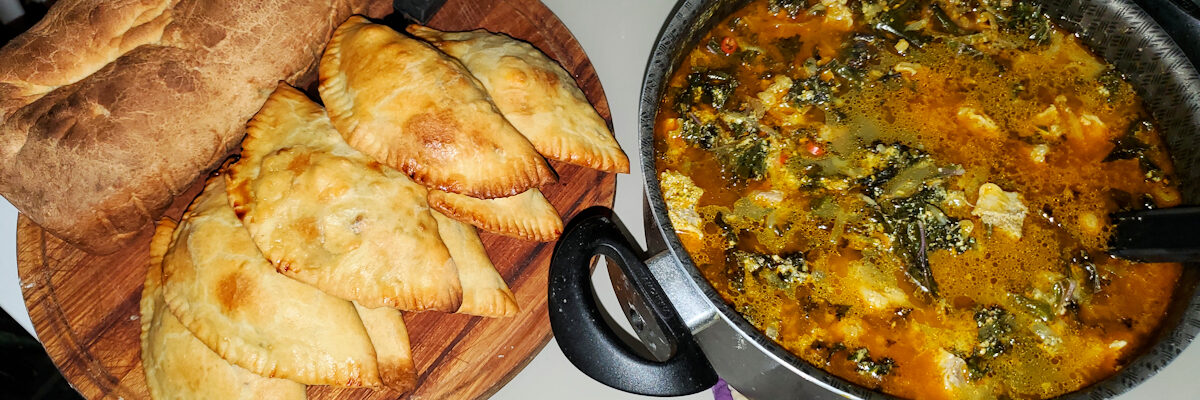
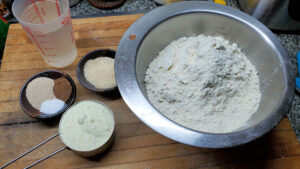
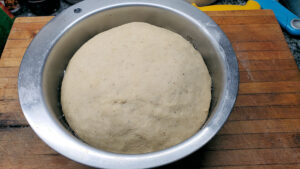
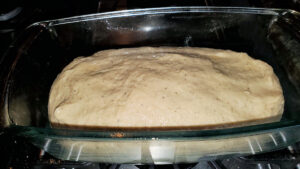
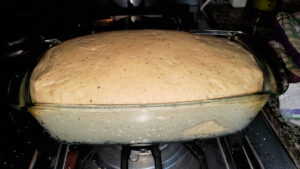
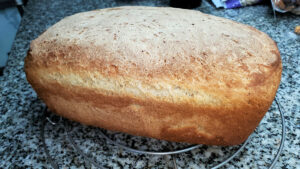
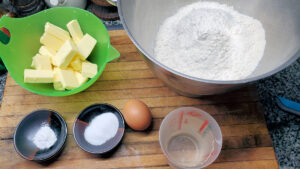
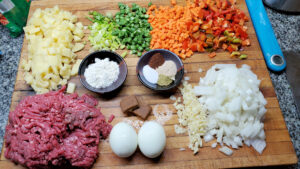
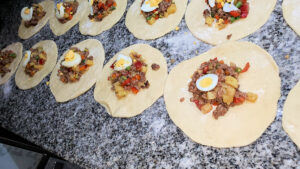
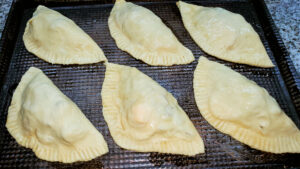
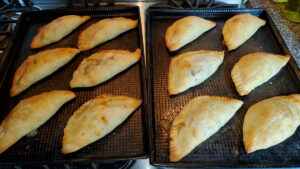
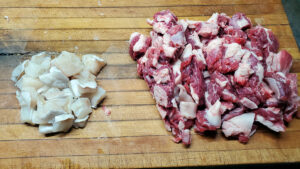
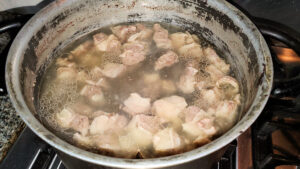
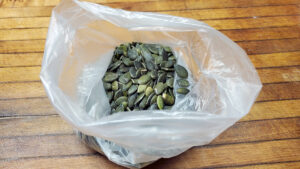
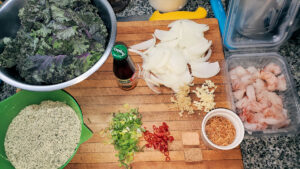
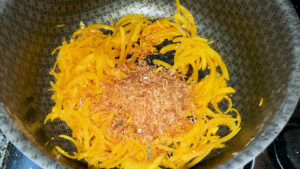
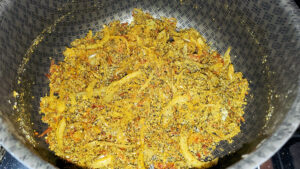
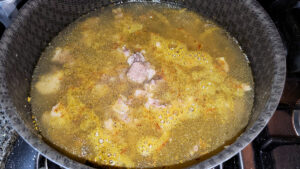
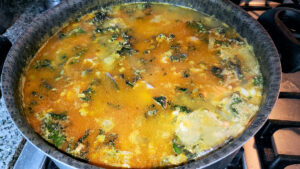
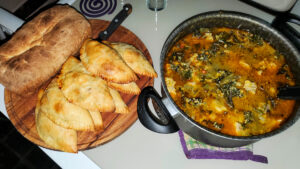
[…] Assuming all goes as planned, next time… we’re headed to Africa, and Cameroon. […]